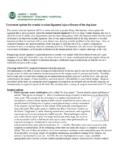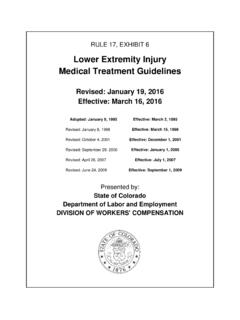Transcription of Physical Rehabilitation Following CCL Repair
1 1 Physical Rehabilitation Following CCL Repair Jody Chiquoine , , ,CCRT Certified Canine Rehabilitation Therapist Member American Canine Sports Medicine Association Physical Rehabilitation in people is well understood and the benefits have been extensively studied and proven. The start of Rehabilitation for humans began in World War I and was noticeably heightened during World War II when more men survived the war (due to penicillin) and needed to return to normal lives. The Vietnam War brought more advanced orthopedic techniques that required early Physical therapy for recovery.
2 By the 1970 s and 80 s Physical Therapy was part of the established standard of care for orthopedic and neurologic problems. In contrast, the use of Physical Rehabilitation for canines in the United States is new and has only been introduced within about the past 5-10 years. Fortunately, it has rapidly gained acceptance. Currently, there are many veterinary research studies that demonstrate the multiple merits of canine Physical therapy. Rehabilitation and hydrotherapy are truly new and exciting adjuncts to traditional veterinary care.
3 Stifle (knee) injuries are the most common orthopedic condition in the Great Pyrenees dog. When assessing the most common stifle injury, rupture of the cranial cruciate ligament (CCL) ranks first followed by luxating patella. Luxating patella is commonly seen in toy and small breeds and is not common in larger breeds. Interestingly, the Great Pyrenees has a much higher incidence of luxating patella than any other large breed dog. Prevention is paramount when discussing Rehabilitation . Therefore, in order to discuss the various approaches to Physical Rehabilitation Following CCL tear it is important to understand the etiology or cause.
4 Common causes of CCL rupture include: direct (acute) trauma to the stifle, luxating patella, previous CCL tear on the opposite leg, poor conditioning, chronic degeneration of the CCL, congenital / developmental conditions. Direct trauma is often associated with jumping up or sudden hyperextension of the hind leg especially when coupled with inward (medial) rotation of the stifle and hind leg. Examples include jumping into a vehicle, missing footing when vigorously jumping out of a vehicle or slipping (ice or slippery floors).
5 Sudden acute rupture can be caused by rigorous play, especially body slamming or hamstringing play for which Pyrs are famous! Prevention: Risk for CCL injury can be minimized by: using a ramp for getting in and out of vehicles and teaching cue words like wait before exiting vehicles or moving onto slippery surfaces. 2 Chronic Degeneration is the most common cause of CCL tears and occurs in most large breeds. The highest incidence is with spayed females age 4-7 years. There is some speculation that early spaying (before12-14 months) reduces hormones required for healthy ligaments.
6 The classic symptom of chronic CCL degeneration can be identified on history as a Pyr that is generally healthy orthopedically but after long rest periods rises and takes a few lame hind leg steps, then walks out of it and is fine. Prevention: Recognize that your Pyr may have a low grade partial CCL tear. Use controlled exercise and massage to allow healthy tissue to form. Minimize rigorous play until symptoms have subsided. Whenever possible, try to avoid sudden transitions from lying to running. Congenital causes of CCL tear include: poor hind angulation (straight in stifles and hocks), luxating patella and lineage trends demonstrating early CCL tears in offspring.
7 Most Pyrs with straight hind angulation or luxating patella will experience a CCL tear sometime during their lifetime. It is interesting to note that most dogs (Pyrs included) with luxating patellas are also poorly angulated in the hind. Prevention: Always purchase your Pyr from a reputable breeder. Keep in mind that even the most conscientious breeder can occasionally have a pup with poor angulation. So, when selecting a Pyr puppy or adult look for well angulated and strong hind legs. Ask breeders about the incidence of stifle problems in the parents and grandparents of the Pyr you are interested in purchasing.
8 The congenitally related CCL tears occur early in a Pyrs life usually from age 6 months to 2 years. Breeders should be notified of the CCL problem and monitor linage. A Previous CCL Tear in Opposite Leg increases the risk of a CCL tear by 30% to 60% within 24 months. Part of this is related to slow return of thigh muscle size and decreased range of motion thereby stressing the other limb. Prevention: As early as possible, seek a professional trained in rehab if your dog has a CCL problem. Studies indicate a reduction in contralateral (opposite leg) CCL tears in dogs that have had rehab.
9 Minimize risk factors such as jumping and high contact play. Poor conditioning is another cause of CCL tears in Great Pyrenees. Like other dogs, Pyrs that are over weight and those that do not have a regular daily exercise regime are at higher risk of CCL tear. In addition, the weekend warrior , or the Pyr that has no daily routine but occasionally is asked to perform in events (carting, agility etc) or go on long hikes (mountaineering, hiking, skiing, snow shoeing, skijoring) is at very high risk of CCL tear. Prevention: Don t be a weekend warrior!
10 Maintain your dog for their lifetime in an exercise program of sustained walking at least 35 minutes 5-6 days per week. Do not allow them to ever be over weight. 3 Treatment Options The formulated Physical Rehabilitation program is based on: the cause of the tear, the degree of the tear, the length of time between tear and treatment and the type(s) of medical or surgical intervention applied by the veterinarian. Conservative Management As previously mentioned, not all CCL s suddenly rupture ; some Pyrs experience slow degeneration of the CCL.

